LSD, chemically known as Lysergic acid diethylamide, is undoubtedly one of the most popular psychedelics known to man, inducing mind altering states of consciousness, spiritual experiences, and “trippy” visuals.
Common street names for this drug are: acid, blotter, cid, doses, dots, and trips.
What exactly is LSD?
In 1938, a Swiss scientist named Albert Hofmann discovered this drug in ergotamine (a grain fungus) while searching for helpful medical derivatives of ergot alkaloid. A few years later, Hofmann accidently tasted the drug and became aware of its intense mild altering powers. He then went on to synthesize it from ergotamine, test it recreationally, and label it as LSD-25.
Creation of this drug can occur through crystal formations or through liquid dilution, and is known to be odorless, colorless, non addictive, and -in its pure form- tasteless. Non-pure LSD may have a slightly bitter or metallic taste. Acid is usually swallowed or dissolved under the tongue, but its liquid form is injection into the veins. You can find this drug sold in the form of tablets, absorbent blotter paper, sugar cubes, or gelatin.
LSD and the Brain
LSD works by binding to serotonin receptors, particularly to serotonin-2A and 5HT2A. LSD appears to reduce the connectivity between regions in the brain that are in charge of cognitive processes, but it increases connectivity in brain networks associated with sensory functions. On top of that, LSD also activates the D1, D2, D4 dopaminergic receptors, the NMDA, mGlu2/mGlu3 glutamatergic receptors, and the TAAR1 receptor.
Main Effects/Side Effects
The effects of an LSD trip vary from person to person, but they all have one thing in common – a psychedelic experience. These experiences include mind altering states of consciousness, audio distortion, wild visuals, synesthesia, an altered sense of time, and spiritual experiences. Intense colors, geometric shapes, morphing objects (even your own body), and ripples in the air are some of the most common “trippy” visuals experienced among LSD users. Depending on your state of mind and mood, the trip may also induce frightening visuals such as scary shapes or beings; this is known as a bad trip. Feelings of panic or anxiety can be experienced with a bad trip as well.
Aside from psychological effects, there are a few physical effects as well; these may include pupil dilation, reduced appetite, increase in heart rate, weakness, restlessness, numbness, nausea, elevated blood sugar, goose bumps, jaw clenching, sweating , and tremors. After an acid trip, impairment of judgment and memory, confusion, and a short attention span may be present; however, there are currently no studies that point to any harsh, long-term effects, of LSD use.
Dosage
A normal full dose of LSD ranges from 100 – 200 micrograms.
Paper blotters are absorbent paper soaked in a liquid solution of LSD. The dosage can vary greatly from one batch to another because there’s no “industry standard”. The same applies with liquid LSD, LSD infused gelatin or sugar cubes etc.
Taking a lower dose is known as “microdosing”, and produces different effects. See Microdosing: Beginner’s Protocol.
Toxicity
There have been deaths by accident under the influence with LSD, but no reported lethal overdoses of LSD.
There have been incidents of people mistakenly taking massive doses of LSD, and even if the trip was definitely not pleasant, no one died due to toxicity levels. For instance, a 49-year-old woman accidentally snorted 55 milligrams (about 550 times more than a standard dose) of LSD, thinking it was cocaine. She required medical attention, but after after about 24hrs, she was once again OK.
How is LSD consumed?
Acid is usually swallowed or dissolved under the tongue, but its liquid form is injectable into the veins. LSD is sold in the form of tablets, absorbent blotter paper, sugar cubes, gelatin and more.
Trip Duration
Acid trips are known for being lengthy, typically lasting between 6-12 hours.
LSD Testing
Potential chemicals that dealers misrepresent as LSD include 25I-NBOMe, DOI, DOC. The NBOMe family of chemicals can be harmful even in small doses, and are often sold as LSD. Many people have died as a result of ingesting an NBOMe compound instead of LSD, therefore it’s essential to get a test kit and test your LSD.
LSD Infographic



